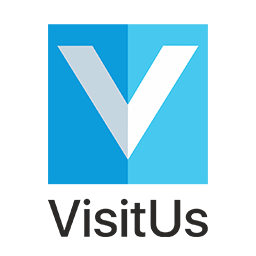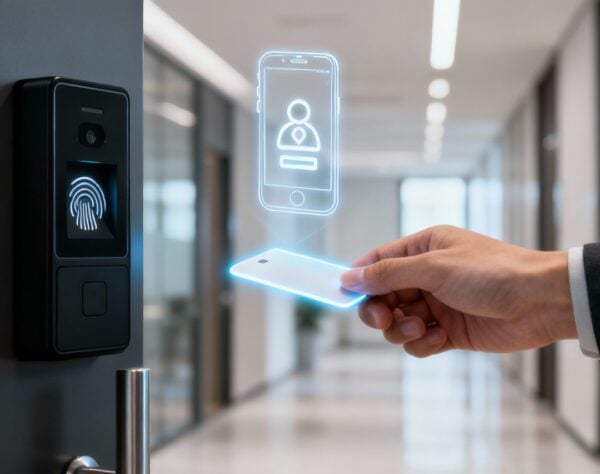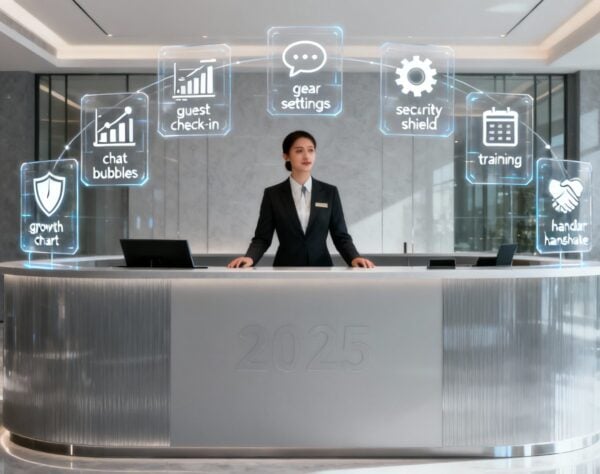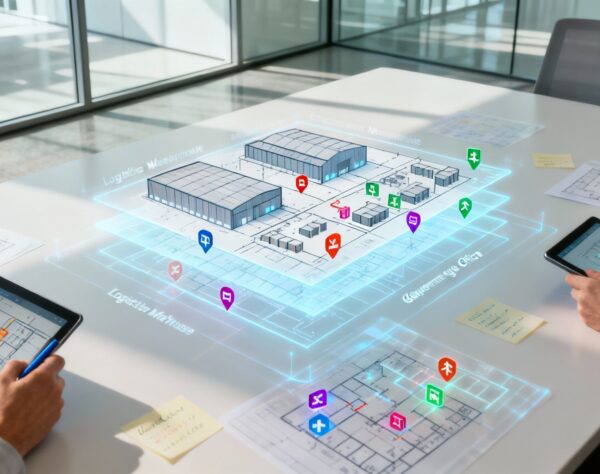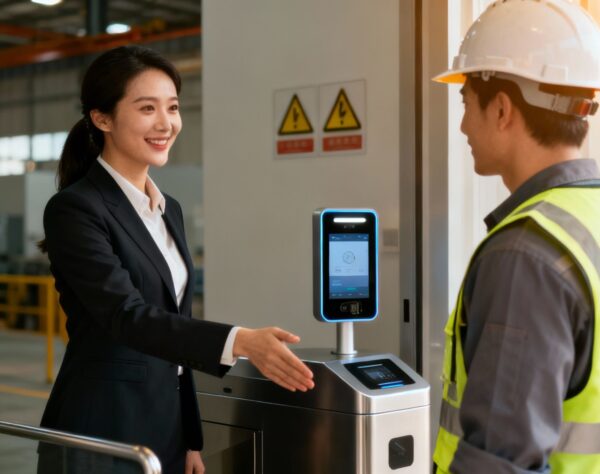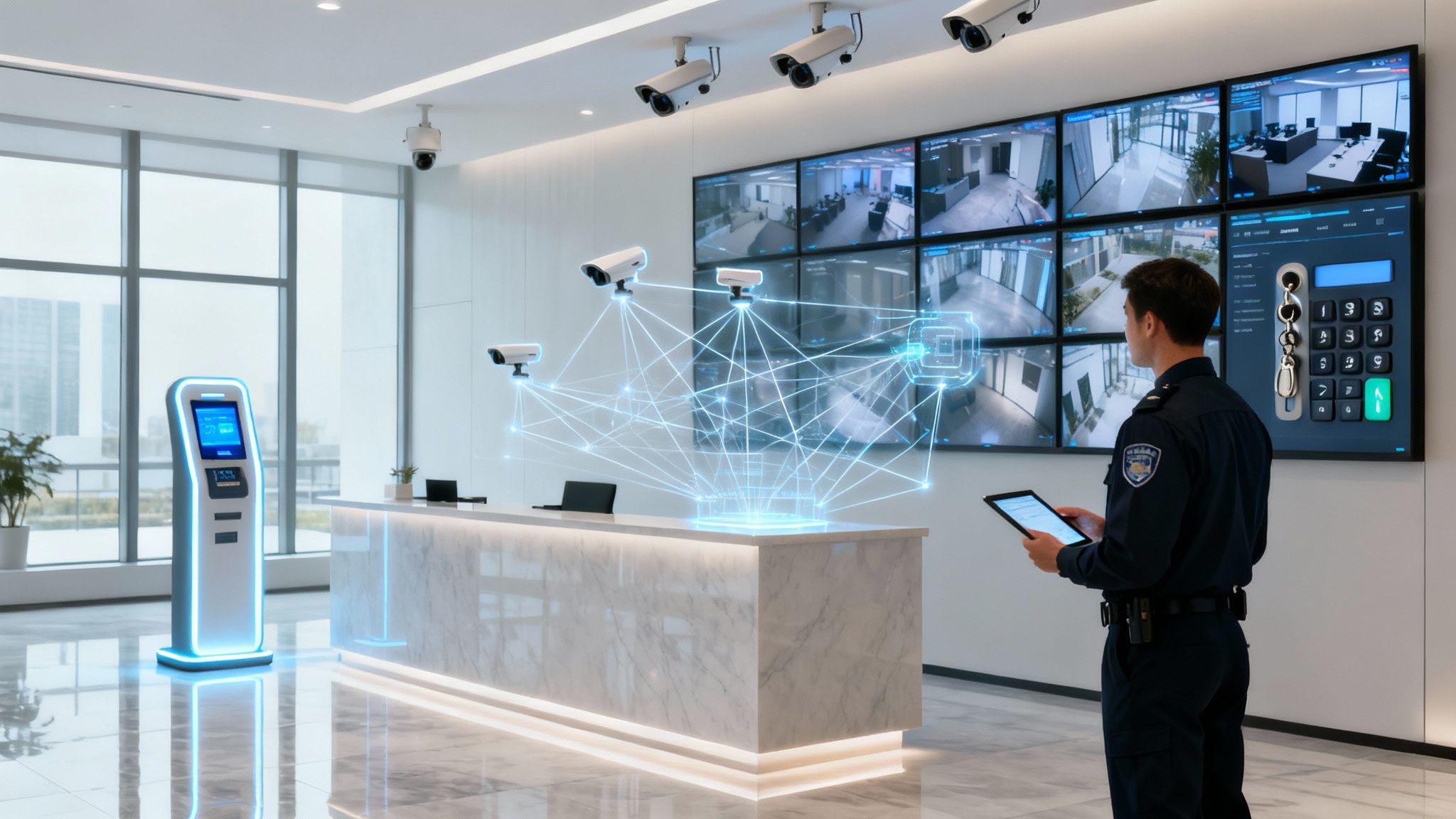
Modern Security for Offices: A Complete Guide
Office security today is about more than just physical protection. It's about safeguarding your entire ecosystem: your people, your data, and your operations. This requires a comprehensive strategy that weaves together physical defences, digital safeguards, and people-centric policies to counter modern threats.
Why Office Security Is No Longer Just Locks and Alarms
Think of your office as a connected ecosystem. A single weak point—an unlocked server room or an employee clicking on a phishing email—can create a ripple effect across the entire business. As a result, the purpose of office security has evolved. It’s no longer just about preventing theft; it's about ensuring business continuity.
This shift focuses on protecting your most valuable assets: your people, sensitive information, and operational stability. A security breach, whether physical or digital, is more than an inconvenience. It can lead to significant financial loss, reputational damage, and operational standstill.
The Modern Security Ecosystem
Today's threats are interconnected. A digital attack might begin with someone physically gaining access to a restricted area, while a sophisticated physical security system could be compromised by a network vulnerability. Your defence must be just as interconnected.
A proactive security strategy is a critical business function, not just a task for the IT or facilities department. It requires a mindset where everyone understands their role in protecting the organisation.
Traditional physical security and digital protection have converged.
The image above perfectly illustrates this idea—a modern lock isn't just a physical barrier anymore; it's a digital access point. The two are now inseparable.
A Growing Need for Professional Safeguards
This new reality is driving a huge demand for professional security solutions across Australia. The Australian Private Security industry is projected to grow by 3% annually through 2026 and already employs over 180,000 people. This growth highlights that Australian businesses recognise the need for comprehensive protection.
Building this protective layer requires more than installing software and cameras. It starts with a solid grasp of the purpose of physical security safeguards and seeing them as the foundation of your entire defence. Even advanced physical deterrents like automatic gates need looking after, and knowing a few commercial automatic gate maintenance tips is key to keeping them working properly. By treating security as one interconnected system, businesses can be far better prepared for the complex challenges of protecting their people and assets.
The Three Pillars of a Modern Security Strategy
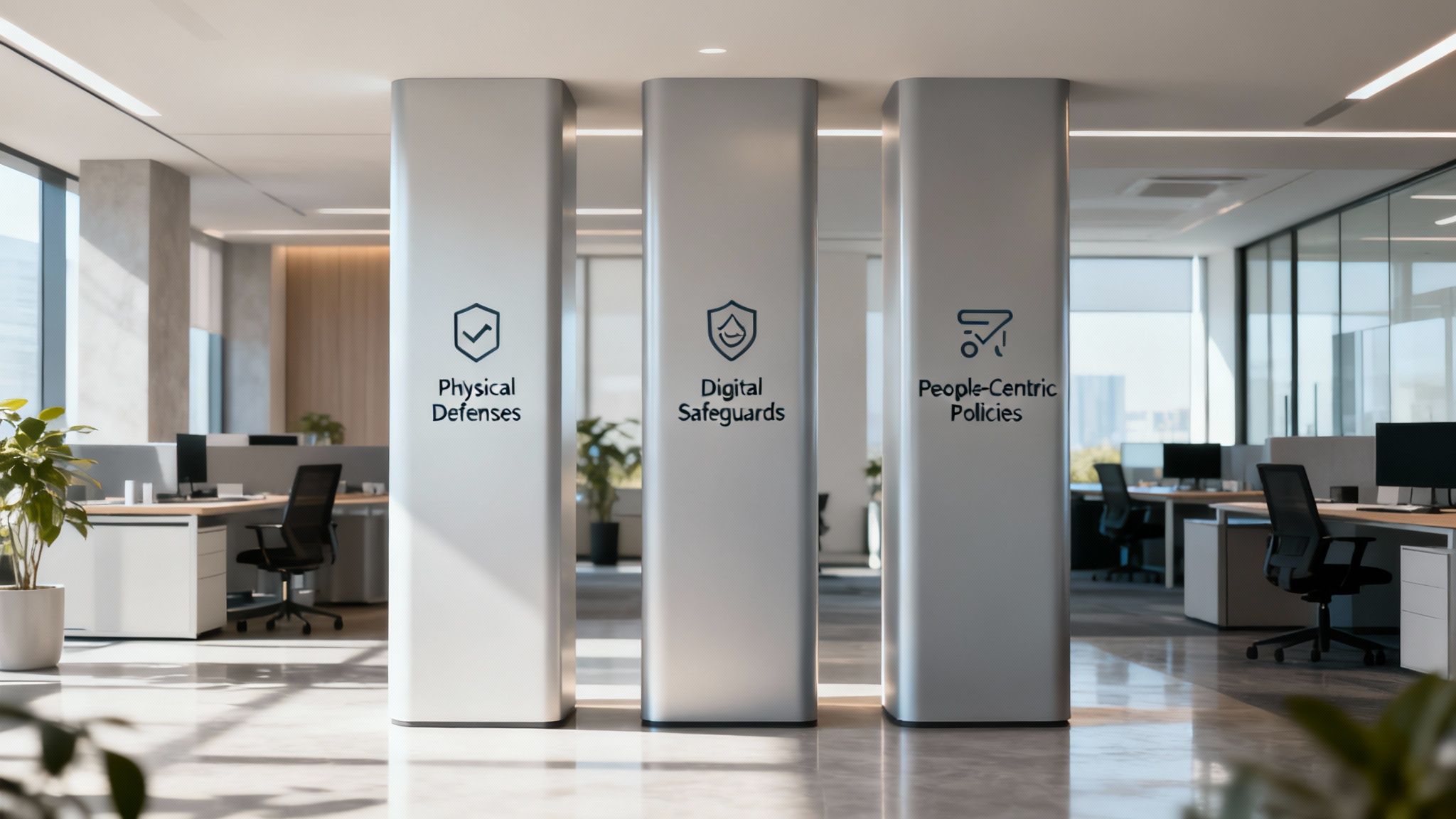
To create a genuinely secure workplace, you need a holistic system built on three core pillars. If one pillar is weak, the entire structure is at risk.
Your security strategy is like a three-legged stool: it needs Physical Defences, Digital Safeguards, and People-Centric Policies to stay balanced. Treating these as interconnected parts of a single strategy builds a much stronger defence for your team, your data, and your property.
Here's a quick breakdown of how these elements work together:
The Three Pillars of Office Security
| Security Pillar | Focus Area | Key Examples |
|---|---|---|
| Physical Defences | Controlling physical access to your premises. | Access control systems, CCTV surveillance, visitor management protocols. |
| Digital Safeguards | Protecting your data, networks, and digital assets. | Firewalls, data encryption, multi-factor authentication (MFA). |
| People-Centric Policies | Turning staff into a proactive security asset. | Security awareness training, clear incident response plans, strong data handling procedures. |
Let's explore what each of these pillars involves.
H3: Physical Defences: Securing Your Space
This is the most tangible part of your security plan—everything that controls who enters your building. It’s your first line of defence, designed to deter, detect, and delay unauthorised individuals.
It starts with basics like solid locks and good lighting but extends to more sophisticated solutions for managing people flow. A layered approach is essential.
Key components include:
- Access Control Systems: Beyond traditional keys, this includes swipe cards, key fobs, or biometric scanners to ensure only authorised personnel can enter sensitive areas like server rooms.
- Surveillance Systems: Modern CCTV offers real-time monitoring and often deters potential threats by its presence alone.
- Visitor Management: Knowing precisely who is in your building at all times is non-negotiable. A proper visitor management system transforms your reception from a weak point into a controlled checkpoint, providing a clear, real-time log of every guest and contractor on site.
Ultimately, this pillar is about control. It empowers you to decide who goes where and when, creating a secure environment for your team.
H3: Digital Safeguards: Protecting Your Data
Your company's data is one of its most valuable assets. This pillar focuses on protecting that information—from customer lists to intellectual property—from the constant threat of cyber attacks.
With Australian businesses reporting a cybercrime every 6 minutes, strong digital defences are non-negotiable. A single breach can cause significant financial loss, ruin your reputation, and halt operations.
Protecting digital assets is no longer just an IT issue; it is a fundamental business responsibility. A breach can compromise everything from employee safety to customer trust, making robust digital safeguards essential for survival.
This requires several layers of defence working together:
- Network Security: This includes firewalls, secure Wi-Fi (with a separate guest network), and tools to prevent unauthorised devices from connecting to your internal network.
- Data Protection: This covers everything from encryption, which makes data unreadable to outsiders, to reliable backup and recovery plans that allow you to restore information after an incident.
- Authentication Protocols: Enforcing strong password rules and multi-factor authentication (MFA) creates a formidable barrier against account takeovers, even if a password is stolen.
By securing your digital assets, you protect the core of your business and ensure sensitive information remains confidential and accessible only to your team.
H3: People-Centric Policies: Your Human Firewall
Technology and physical barriers are not enough. The third, and arguably most crucial, pillar of office security is your people. A well-trained, security-aware team is your best defence against a wide range of threats, particularly social engineering and human error.
In fact, human error is a factor in 82% of all data breaches. This pillar focuses on transforming your employees from potential liabilities into a proactive "human firewall" through clear policies, regular training, and a strong security culture.
This isn't about simply handing out a rulebook. It's about embedding security awareness into your company's DNA.
Effective people-centric security involves:
- Security Awareness Training: Regular sessions on spotting phishing emails, using strong passwords, and recognising social engineering tactics are vital.
- Clear Protocols and Procedures: Your team needs simple instructions on handling sensitive data, reporting security concerns, and managing visitors. This also covers the importance of compliance at work to meet legal and industry standards.
- Incident Response Plans: Everyone should know what to do if a security event occurs. A clear, practiced plan ensures a fast, organised response that minimises damage and disruption.
When your people understand why security rules exist, they become active partners in protecting the business, creating a culture of shared responsibility that technology alone cannot replicate.
Securing Your Digital Fortress From Modern Threats
While physical barriers are a good start, the most common threats to today's offices are digital. Your company’s data is a prime target for online attackers, and a breach can lead to massive financial losses, reputational damage, and a complete loss of customer trust.
For Australian businesses, this is a daily reality. The Office of the Australian Information Commissioner (OAIC) recorded a 26% increase in notifiable data breaches in the second half of 2023. Malicious attacks remain the leading cause of these breaches, accounting for 67% of all incidents. This is a clear sign that our digital defences are constantly being tested.
Building Your Digital Defences
Effective digital security for offices requires layers of protection that work together. If one defence fails, another is there to stop the threat.
An excellent first step is implementing multi-factor authentication (MFA) for all company accounts. MFA requires two or more forms of verification to log in, making it incredibly difficult for unauthorised users to gain access, even with a stolen password. To learn more about this powerful tool, see our guide on what two-factor authentication is.
Beyond that, put these fundamentals in place:
- Regular Security Audits: Proactively scan your networks and systems to identify and patch vulnerabilities before an attacker can exploit them.
- Solid Backup and Recovery Plans: Regularly back up all critical business data. A robust recovery plan ensures you can restore operations quickly with minimal data loss after a ransomware attack or system failure.
Securing the Modern Remote Workforce
The shift to flexible work has introduced new security challenges. When employees connect from home, they are often outside the secure perimeter of the office, making their connections an attractive target for attackers seeking entry to your network.
Securing remote connections isn't an optional extra anymore; it's a core part of any modern office security plan. Every laptop or phone connecting from home is a potential doorway into your company network.
To close this gap, extend your digital fortress beyond the office walls with clear, enforceable rules for remote work.
Focus on these key areas to keep your remote team and business safe:
- Virtual Private Networks (VPNs): Mandate the use of a VPN for anyone accessing the company network remotely. A VPN creates a secure, encrypted tunnel that protects data from interception, especially on public or unsecured Wi-Fi.
- Device Management: Implement clear policies for securing all devices used for work, whether company-issued or personal. This includes ensuring they have up-to-date antivirus software, firewalls, and the latest security patches.
- Employee Training: Educate your team on the specific risks of remote work, such as targeted phishing scams and the importance of securing home Wi-Fi networks.
By implementing these measures, you can build a digital defence that protects your business's valuable data, no matter where your team is working from.
How Smart Visitor Management Strengthens Security
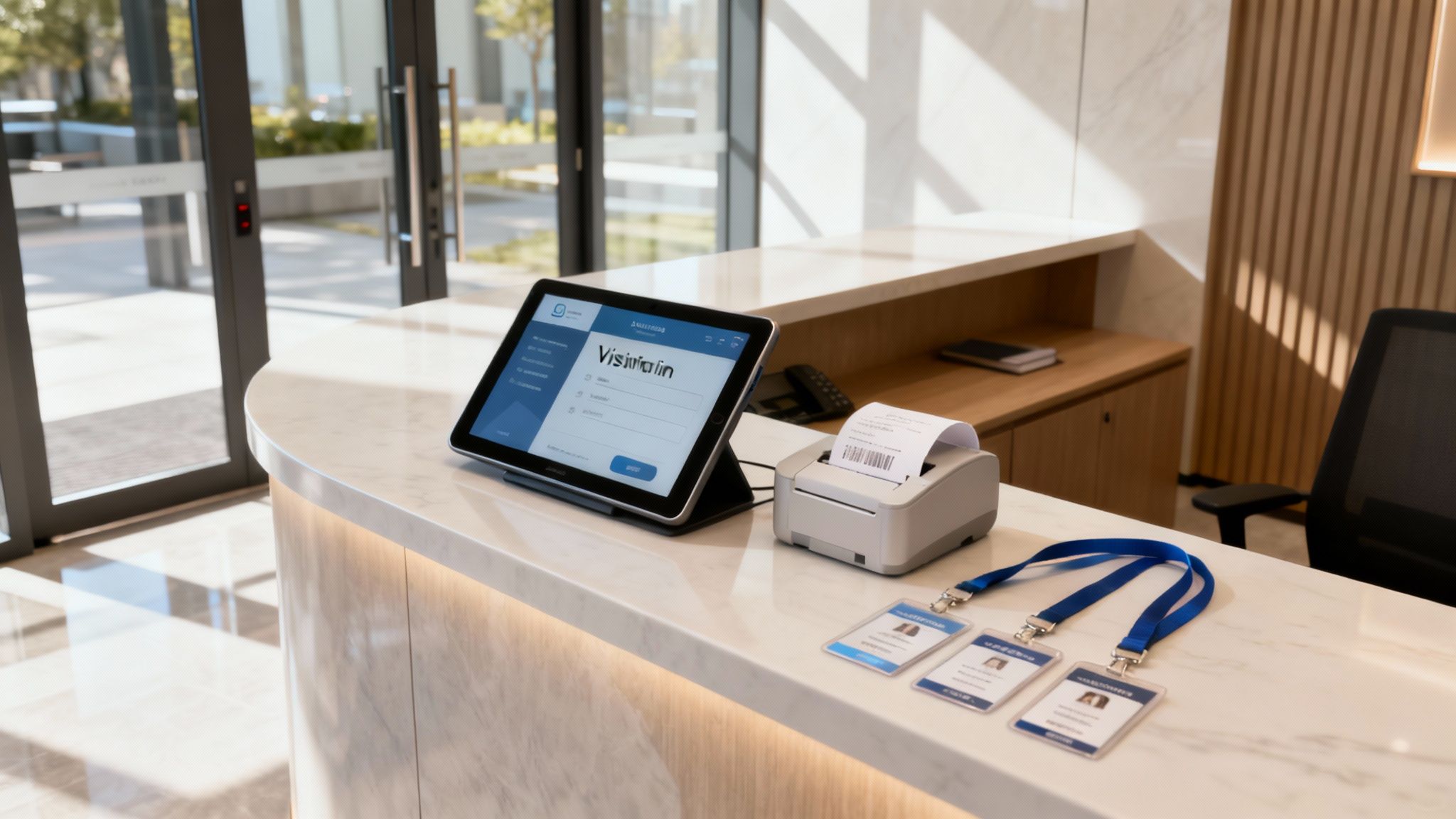
Your front desk is the main entry point to your entire organisation. Daily traffic from employees, clients, contractors, and couriers can easily turn this welcome mat into your biggest security liability without a solid process.
The traditional paper logbook is a relic riddled with risks. It’s unreliable, offers zero real-time insight, and compromises privacy. A shocking 93% of office visitors admit they could see confidential information on paper sign-in sheets left in plain view.
A modern Visitor Management System (VMS) transforms your reception from a weak link into a smart checkpoint, actively strengthening your overall security for offices.
Gaining Complete Situational Awareness
The primary benefit of a smart VMS is complete, real-time visibility of everyone in your building. This immediate awareness is crucial for safety and impossible to achieve with a paper log.
In an emergency, like a fire alarm, a VMS provides an instant, accurate list of all non-employees, ensuring you can account for everyone. A staggering 74% of organisations admit they cannot account for all visitors and contractors during an emergency drill. A VMS closes this dangerous gap, allowing you to provide critical information to first responders and ensure visitor safety.
A digital visitor system turns ambiguity into certainty. Knowing precisely who is on your premises is not just a security feature—it's a fundamental requirement for ensuring everyone's safety during a critical event.
This capability is also vital for meeting workplace health and safety (WHS) obligations. A reliable, time-stamped digital trail of every entry and exit provides crucial data for compliance audits and incident investigations.
Proactively Preventing Unauthorised Access
A VMS acts as a digital gatekeeper, ensuring only approved individuals gain entry. It shifts your security from reactive to proactive by verifying each visitor's identity and purpose before they pass reception.
This proactive process provides multiple layers of protection and control:
- Ensure Every Visit is Legitimate: When a visitor signs in, their host receives an instant notification via email or SMS. This confirms the appointment is valid and prevents visitors from wandering unescorted.
- Screen for Potential Risks: You can screen visitors against internal watchlists, automatically flagging anyone who may pose a risk before they are granted access.
- Create a Verified Record: Unlike a paper log where "Mickey Mouse" could sign in, a VMS can require a photo capture or ID scan, creating a trustworthy record of who is actually on your premises.
This structured check-in process does more than track people; it actively deters unauthorised access. The presence of a formal, digital system sends a clear message that you take security seriously.
Enhancing Professionalism and Efficiency
Beyond critical security benefits, a smart visitor management system improves your business's image. A messy paper sign-in suggests your organisation is outdated, while a sleek tablet sign-in is professional, quick, and welcoming.
This streamlined process offers benefits for everyone. Visitors enjoy a smooth, fast check-in. Reception staff are freed from manual paperwork to focus on more valuable tasks. Our guide on enhancing workplace security with a visitor sign-in system explores how this efficiency creates a safer environment.
A VMS also provides valuable operational data. You can track visitor trends, monitor contractor hours, and identify peak traffic times. This information helps you staff your front desk more effectively and make data-driven decisions about facility management.
Integrating Technology to Stay Ahead of Threats
Security threats evolve, so your defences must too. Relying on isolated systems—a standalone camera and a separate access reader—is like having security guards who don't communicate. To build a robust defence, you need security technologies that work together as one smart, responsive system.
Connecting your access control, surveillance cameras, and visitor management allows them to share information, painting a clearer picture of what’s happening across your facility and enabling faster, more effective reactions.
Creating a Unified Security Platform
An integrated system turns separate data points into actionable intelligence. For instance, when a visitor signs in, the system can automatically grant them temporary access to specific doors while logging their entry on camera, creating a seamless and auditable trail.
The real advantage here is shifting from a reactive to a proactive security posture. Instead of just reviewing footage after something has happened, an intelligent system can flag unusual activity in real-time, giving you a chance to stop a problem before it even starts.
This connected approach provides your team with the full story needed to make quick, informed decisions when every second counts.
The Growing Role of Automation and AI
Modern security technology is becoming increasingly intelligent. Artificial intelligence (AI) and automation are transforming workplace protection by teaching systems to recognise patterns and spot abnormal behaviour without constant human supervision. This doesn't replace your security team; it enhances their capabilities.
AI-powered analytics can monitor camera feeds to:
- Identify a person entering a restricted area after hours.
- Detect a vehicle lingering near an entry point.
- Flag when a secure door has been propped open.
These systems can automatically trigger alerts, lock down areas, and notify the right people, enabling an incredibly fast response. This is crucial as security threats become more complex. The Australian Security Industry Association Limited (ASIAL) has highlighted automation as a key trend for boosting efficiency. You can discover more insights about these evolving security trends.
Building a System That Learns and Adapts
The goal of integrating your security for offices is to build a system that gets smarter over time. By analysing data from access logs, visitor check-ins, and camera feeds, it learns what "normal" looks like for your workplace.
This learning ability allows the system to fine-tune alerts, reducing false alarms and ensuring your team focuses only on genuine threats. An adaptive defence is far more effective than static rules that can quickly become outdated.
Of course, planning for advanced solutions requires understanding practicalities like security camera installation costs. However, the long-term benefit of a unified, intelligent platform is undeniable. It delivers security that is stronger, more efficient, and prepared for the threats of tomorrow.
Common Questions About Office Security
Upgrading your office security can seem daunting. Answering key questions can help you make confident decisions to protect your workplace, people, and assets.
Where Do I Start with Improving My Office Security?
Begin with a simple risk assessment. A walk-through of your office can reveal key vulnerabilities across the three security pillars: physical, digital, and people.
Ask basic questions. Can anyone walk past reception unchallenged? Is your guest Wi-Fi network completely separate from your internal network? Does your team know how to identify a phishing email?
Answering these questions helps you pinpoint your biggest weaknesses. From there, you can prioritise the most immediate risks. Often, the most effective first steps are not the most expensive. A modern visitor management system or enforcing multi-factor authentication can provide a significant security boost for a relatively small investment.
How Can I Secure My Office on a Tight Budget?
Effective office security is more about smart planning than big spending. Your team is one of your most powerful and affordable security assets. Building a security-aware culture through regular, straightforward training provides a high return on investment at a minimal cost.
For digital security, many of the best defences are free:
- Enforcing a strong password policy with regular updates costs nothing.
- Enabling multi-factor authentication is a standard feature on most business software and creates a massive barrier against account takeovers.
For physical security, focus on protecting critical assets and entry points first. A modern visitor management system, for example, offers a massive security upgrade over a messy, insecure paper logbook. The benefit of knowing exactly who is on-site provides a level of control that’s far cheaper than hiring additional front-desk security staff.
What Is the Role of Employees in Office Security?
Your employees are the most critical component of your security program. Technology is a tool, but a well-trained team is your first line of defence against everything from cyber attacks to physical intruders.
Their role is active participation, not just rule-following. This includes simple habits like locking their computers when they step away and knowing how to report a suspicious email immediately. Everyone must understand their personal responsibility in keeping the workplace safe.
Technology creates barriers, but people create a culture of security. When your team views security as a shared value rather than a list of rules, you transform every employee into a proactive security asset.
This sense of collective ownership builds a human firewall that is more adaptable and intuitive than any software.
How Does a Visitor Management System Improve Security?
A visitor management system (VMS) makes your office instantly more secure by replacing the chaotic paper logbook with a controlled, digital, and trackable process. Its greatest benefit is providing complete, real-time knowledge of who is in your building—a non-negotiable for both daily safety and emergency planning. A VMS immediately closes the dangerous gap revealed by the 74% of organisations that admit they can't account for all visitors during an emergency.
A VMS strengthens physical access control by ensuring every guest is expected and approved by a staff member before they pass reception. It also creates a permanent, searchable digital log of every visit, which is crucial for compliance audits and incident investigations. In short, a visitor management system secures your front door—the most exposed entry point in any office—by turning your welcome mat into an intelligent checkpoint.
Ready to transform your front desk from a vulnerability into a security asset? VisitUs provides a secure, cloud-based visitor management system that gives you complete control and real-time visibility over who is in your building. Learn more about how VisitUs can strengthen your office security.
